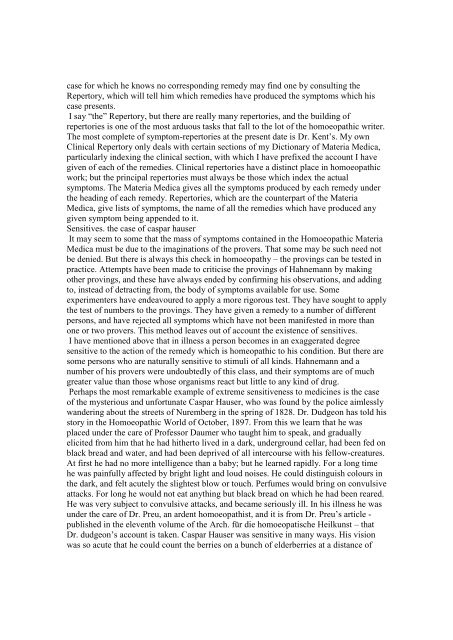CLARKE JH, Homoeopathy Explained - Classical Homeopathy Online
CLARKE JH, Homoeopathy Explained - Classical Homeopathy Online
CLARKE JH, Homoeopathy Explained - Classical Homeopathy Online
Create successful ePaper yourself
Turn your PDF publications into a flip-book with our unique Google optimized e-Paper software.
case for which he knows no corresponding remedy may find one by consulting the<br />
Repertory, which will tell him which remedies have produced the symptoms which his<br />
case presents.<br />
I say “the” Repertory, but there are really many repertories, and the building of<br />
repertories is one of the most arduous tasks that fall to the lot of the homoeopathic writer.<br />
The most complete of symptom-repertories at the present date is Dr. Kent’s. My own<br />
Clinical Repertory only deals with certain sections of my Dictionary of Materia Medica,<br />
particularly indexing the clinical section, with which I have prefixed the account I have<br />
given of each of the remedies. Clinical repertories have a distinct place in homoeopathic<br />
work; but the principal repertories must always be those which index the actual<br />
symptoms. The Materia Medica gives all the symptoms produced by each remedy under<br />
the heading of each remedy. Repertories, which are the counterpart of the Materia<br />
Medica, give lists of symptoms, the name of all the remedies which have produced any<br />
given symptom being appended to it.<br />
Sensitives. the case of caspar hauser<br />
It may seem to some that the mass of symptoms contained in the Homoeopathic Materia<br />
Medica must be due to the imaginations of the provers. That some may be such need not<br />
be denied. But there is always this check in homoeopathy – the provings can be tested in<br />
practice. Attempts have been made to criticise the provings of Hahnemann by making<br />
other provings, and these have always ended by confirming his observations, and adding<br />
to, instead of detracting from, the body of symptoms available for use. Some<br />
experimenters have endeavoured to apply a more rigorous test. They have sought to apply<br />
the test of numbers to the provings. They have given a remedy to a number of different<br />
persons, and have rejected all symptoms which have not been manifested in more than<br />
one or two provers. This method leaves out of account the existence of sensitives.<br />
I have mentioned above that in illness a person becomes in an exaggerated degree<br />
sensitive to the action of the remedy which is homeopathic to his condition. But there are<br />
some persons who are naturally sensitive to stimuli of all kinds. Hahnemann and a<br />
number of his provers were undoubtedly of this class, and their symptoms are of much<br />
greater value than those whose organisms react but little to any kind of drug.<br />
Perhaps the most remarkable example of extreme sensitiveness to medicines is the case<br />
of the mysterious and unfortunate Caspar Hauser, who was found by the police aimlessly<br />
wandering about the streets of Nuremberg in the spring of 1828. Dr. Dudgeon has told his<br />
story in the Homoeopathic World of October, 1897. From this we learn that he was<br />
placed under the care of Professor Daumer who taught him to speak, and gradually<br />
elicited from him that he had hitherto lived in a dark, underground cellar, had been fed on<br />
black bread and water, and had been deprived of all intercourse with his fellow-creatures.<br />
At first he had no more intelligence than a baby; but he learned rapidly. For a long time<br />
he was painfully affected by bright light and loud noises. He could distinguish colours in<br />
the dark, and felt acutely the slightest blow or touch. Perfumes would bring on convulsive<br />
attacks. For long he would not eat anything but black bread on which he had been reared.<br />
He was very subject to convulsive attacks, and became seriously ill. In his illness he was<br />
under the care of Dr. Preu, an ardent homoeopathist, and it is from Dr. Preu’s article -<br />
published in the eleventh volume of the Arch. für die homoeopatische Heilkunst – that<br />
Dr. dudgeon’s account is taken. Caspar Hauser was sensitive in many ways. His vision<br />
was so acute that he could count the berries on a bunch of elderberries at a distance of
















